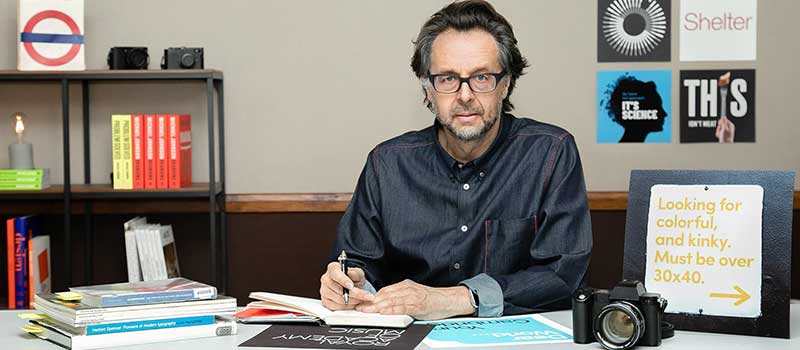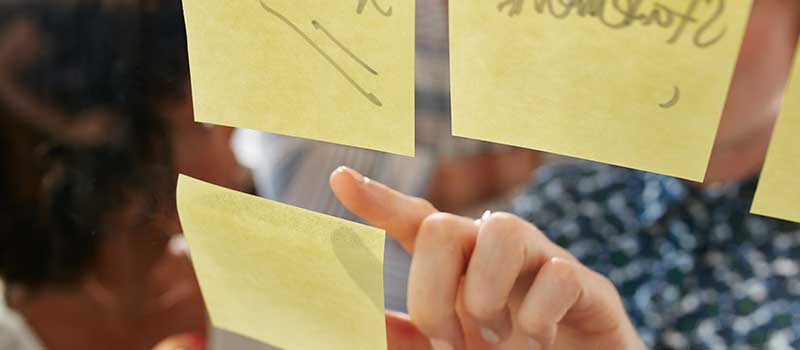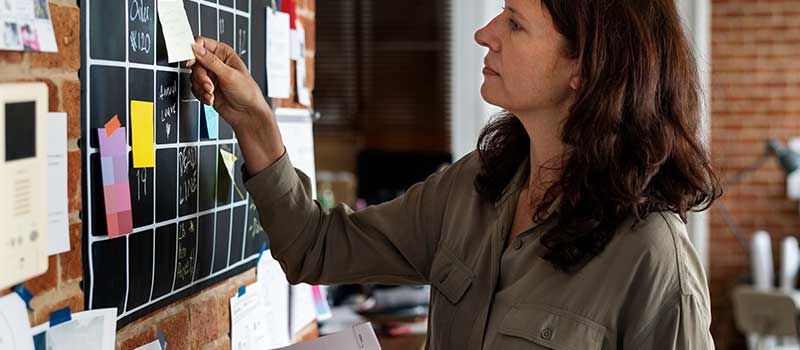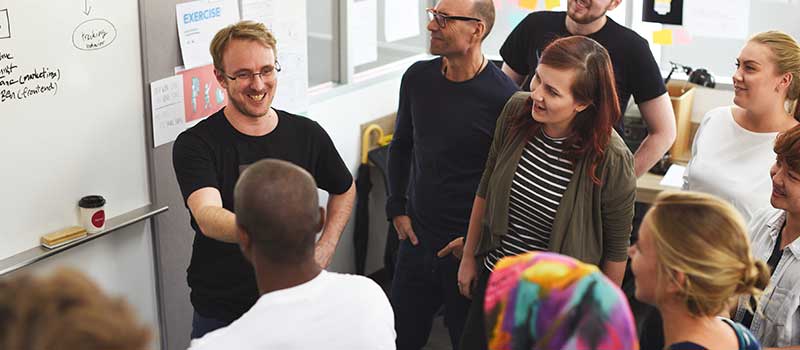Michael Johnson an author of one of the best branding books out there which is Branding in five and a half steps.
He created the agency Johnson banks way back in 1992, after learning his trade in brand consultancy, design and art direction, all over the world from London to Tokyo, to Sydney and beyond now,
Michael is also a lecturer in universities across the UK, a regular speaker at the world’s leading design and branding conferences while the independent selected them as one of the 10, most notable British designers.
In this article, Michael Johnson shares his experience on how Johnson banks progressed to offering strategy alongside design, the most effective exercises to perform with clients and how workshop collaboration and branding is a unified approach.
So, if you want to learn from one of the most notable designers in the UK about how to run a successful strategy and creative agency, then stick around for this article
How Global Agency Johnson Banks Began

Stephen Houraghan
So you’ve been going all of these years and I really wanted to kind of get a feel from your perspective the kind of journey into starting your agency way back then in 1992.
How you arrive at that moment to create that agency and what those early months and that first year were like?

Michael Johnson
Well, I think the truth is that I was one of those slightly chippy 20-year-old designers and we all know them and meet them yet. Very, very rarely give them a job because they have trouble writing on their forehead.
But I was one of those and I had a series of jobs in my twenties as a graphic designer, principally,
I started off at more filings as a consultant and then I got to work out how to use my hands and become a designer.
This is a long time ago now, I think at the end of the day, I had a dream that when that dream, that sounds a bit, I think in my head, I thought maybe I could start a company by the time I was 30 as it happened.
Turned out to be slightly unemployable by about the age of 28. And then I was sort of slightly lumped into starting a company I went through that.

At the time I did have a client who had got in well with, and we started this thing, Banks, I was the Johnson, he was the Banks. And we started something that was kind of like doing if you like corporate design.
And that lasted okay for a couple of years. And then we kind of had, what did they say in the music? We will have musical differences.
He left quite soon, only after about three years. but I kept the name because I liked it.
So it made it sound big and to answer your question properly.
We rarely, really spent the 90s just trying to do the best graphic designer could do, I won’t pretend that I was trying to change the world or change the graphic design.
I was just trying to prove that I could run a design company that did decent graphic design and 90s graphic design in Britain was an interesting point.
Trying to come out of that 70s, 80s idea thing, but like slightly tweak if you like the design at the time, reacting to new companies, like why not associates and tomato who were very hip at the time.
And that had quite a seismic effect on the business and that was quite an interesting time to be at graphic design.
Why Brand Strategy Has Become So Important

Stephen Houraghan
Have you seen an increased understanding and an appetite for what brand strategy is and how important it is?
Because back then, clients didn’t really have the words to really define what it is that they were looking for.
Now, it seems brand strategy is topical and clients need to understand that more.
Is that what you’ve also found that there’s more of an appetite for strategy?
They understand what it is and they’re coming to you wanting more?

Michael Johnson
Yes. I think it was, we’d go back to that time 20 years ago.
It was the tumbleweed really in terms of how you spend most of your first meeting, just explaining what you thought a brand was and no one was clear.
Now 20 years later, a lot of the things that might’ve been doing 20 years ago have been quite a lot of those presents that have been taken in-house because organizations understand them so well.
I don’t think I’ve done a SWOT analysis for a decade because that’s so often been done in-house.
Increasing the clients, organizational educational, philanthropic, whatever have done where we are. They’ve done a kind of, a bit of a market and now.
Quite a lot of them have done some values because that’s been taken on board by an HR function.

I don’t think it’s been a while since I’ve used a 10 slide explaining what a brand is.
Whereas I used to have to use this all the time 10, 15 years ago, and now it’s quite rare because I can pretty much get into it and we will say, well,
Here there’s a problem. And this is how we’re going to do it.
Yes in answer to your question. I do think that has changed. I mean, I suppose you have to temper that with the fact that you and I have been doing this awhile and it seems more obvious and we are looking aren’t we looking for evidence.
That brand is everywhere. It does feel, the battle has been won.
One brand is anywhere you could paradoxically say, but that perhaps we’re now at the other end of that, where you’re starting to get these battles about what’s the purpose of the brand and why are all these blue-chip organizations pretending that they’re changing the world where they’re not?
PRO Brand Strategy BluePrint
Build Brands Like A Pro Brand Strategist

How To Find The Right Problems To Fix

Stephen Houraghan
I think you’re 100% right because we’ve got all these debates going on about the purpose of purpose and the whole vision of mission and how irrelevant they are in this day and age.
They’re kind of old hat, but at the same time, I think, as you come down. , the latter a little bit to the medium to smaller sized companies.
I think it’s only now that these guys are catching up and in some cases,
You still have to enlighten them or kind of show them that there are more than just visual problems to solve.
And this is a quote from your book:
Creatives end up creating fantastic solutions for the wrong problems.
What are some of the ways that we can kind of open up that discussion of bigger problems to clients if they are just focused on those visual problems?

Michael Johnson
90% of my clients are not coming to us because they don’t sit in a meeting and say, we need a new and we very rarely have that conversation.
90% of the meetings are about the initial meetings are about something’s wrong here.
We’re in the wrong place where we’re not understanding our market.
People seem to have a misperception of us or so the vast amount of time people are coming to us, which with what we would call a strategic problem.
We will then endeavor to spend some time.
It could be weeks, it’s often months trying to understand what that strategic problem is.
So to your question, we can start by working out what the real problem is and start the design phase, which is our third phase in the right place because there’s nothing worse than, and of course I still do it as a boil me down to glue and I’m still a graphic designer.
I still sit there in the meeting too and think, oh, I’ve got it. I’m scribbling it in my notepad and that might affect my cloud of judgment but I’ve got to kind of park that design part of my head for a bit until I’ve worked out quite where they should be because it is a complete waste of time.
I suppose that ties in into how important you see the brand audit which is something that you said.

If you’ve just ended up doing some slam dunk, an amazing kind of whoosh bang graphic design, the whizzbang idea for a client who just doesn’t need that or wants that. Of course, there are some plants who want that.
So if I started doing this study thinking harder about this really, because I spent my twenties designing, what I thought were great ideas, but having, because I had no contact with the client, really, I was just buried in organizations.
I just had no perception of what they really needed and so I guess that’s really underlying everything that I’ve been talking about for 25 years, really, which is you’ve got to understand where someone isn’t at.
Before you can take them forward because otherwise you just might try and take them too far. And that’s just a waste of time.
You would need to understand their frame of reference and then just push them slightly out of it rather than pushing them over the edge.
Explore Brand Strategy
Programs & Tools
The Importance Of The Brand Audit

Stephen Houraghan
In your book, you talk about the visual, the verbal, the behavioral, the competitor audit.
How do you find that information?
How do you collate it and then present that information?
Is it based on positive findings and negative findings based on insights?
How do you go about that?
What’s your process like?

Michael Johnson
It’s kind of a mixture, we still do a lot of interviews, the one-to-one.
Talking to people about what the problem is, get them out of the boardroom.
Well, back on zoom at the moment, but of course originally we did that face to face so that there weren’t a group of people all telling them what they should think.
What do they really think? lots of visual audits.
What they are doing, what they are saying, what their competitors are doing and saying, and once we got all that information, we’re starting to the interviews are of course really helpful because
We get a sense of what the real problem is and the answer is within an organization.
I don’t really believe that someone like me just comes wheeling in and with the magic bullet sort of validity of what I think.
There is an answer within, within an organization, but the interviews are a bit like a bell curve and you quickly find out what really is going on in the visual audits.

I kind of flip flop about that, but actually I’ve discovered that two you’re really, to your question is just telling people, showing people what everyone else is doing.
Isn’t actually that useful but having felted those 70 slides down to seven key slides, these are the insights that we can tell you from your market and look what everyone else is doing.
I think one of the key things that we find is the tendency of a market to be like sheep in a to follow each other.
Whether it be finding replacements for leather, we’re doing a project at the moment, which is like organic, leather replacements or positioning universal cultural organizations talk about themselves to three very different markets, but it’s always amazing to me how they all share the same language.
And so those kinds of audits are often really useful for me, because then I can say to a boardroom with just six, eight weeks in, look, this is what everyone else is saying.
Do you want to be the same as them? And that can be a very direct question. I mean, sometimes they say yes, and we sort of gently extricate ourselves from the process because he wants the point of being exactly the same as everyone else.
But 9 times out of 10, they say, gosh, you, no, yeah, we know, oh gosh, we get it.
And they start to then understand the position process or the differentiation or whatever word you want to use. We might draw some maps and we sort of say, well, look, this is
Where they are.
Why do you want to be there?
What do you want to do?
You want to put yourself in a slightly different place?
And then bit by bit, especially if they’re not trained marketeers, they start to say Oh, I get it now, we need to be in two places at once.
How are we going to do that? Those things that you said that your initial phase, it could go on for weeks or even months.
The Importance Of Client Exercises

Stephen Houraghan
Obviously, a lot of what goes on in this process are exercises and there’s a section in your book, simple exercises, big outcomes.
What do you feel are the most effective exercises to perform with the client?
And then what kind of exercises do you perform without them?

Michael Johnson
I think it depends a bit on the project.
I think the truth is that what we are trying to do usually is we’re trying to get through our insight stage pretty fast. It’s not always possible.
Some clients we might need to do 40 interviews.
I think the most useful bit of work that we do with our clients is in our second stage where we’ve come to them with a sort of roughed-out slides about,
What’s an instance that we think that they do what we think their market is.
And then they really get into that. There’s lots of shouting and writing on paper or writing in Google docs now, and then.
Then the absolute key to our process at least is when we get to the bit more.
So why are you here?
What’s your core?
What’s the core idea at the core of you?
And at that stage, we will not just go to them with one.

We will nearly always position it at least three ways of doing that.
The most powerful part of this process, I think, is whether they like it or not even the biggest naysayer on any client’s side and it’s presented with three slides and within 80 words, a headline and 80 words.
Then you can almost literally see the penny drop and go, oh, crikey, I see what you mean.
So if we do that, that makes us seem like this.
If we taught like that then, and all of a sudden, all the principles of strategy brand in the Brandeis brand narrative, positioning, differentiation, all of those things are kind of distilled down into three sides and pennies.
Simultaneously and that if one was being really reductionist to your question, that is the absolute key to the process.
I found the key to the process is if I want my clients to really engage in this.
It’s not to tell them who they are is to say, we think you could be one of these.
The Importance Of Unifying The Leadership Team

Stephen Houraghan
The language that you use is so important in terms of guiding your client in the right way.
If you tell them what they need to be, you’re going to get a lot of pushback.
Whereas if you kind of invite them in, if you guide them in, and if you kind of position it in a way that it’s nearly their idea and their decision, then they’re going to be invested in it.
And you speak about this in your book as well you touch on Disenfranchised key directors who feel that they’re not consulted and this is obviously a common problem.
We’ve all heard the stories or, had the experiences of clients coming back with change after change, after the change and that’s where I feel that.
This all comes from the fact that they feel that they haven’t been consulted.
They feel that they’re not involved in the PR in the process.
How do you make sure that you avoid that and make sure that they feel like they’ve been part of the whole thing?

Michael Johnson
The Lone Wolf, those are the kind of real Passat tactic that is difficult in some cases.
So when we did a big project on, are still doing a big project for Cambridge university that became, has become quite famous, which was about repositioning an 800-year-old institution effectively.
They tried to write some narrative. It was like what I call kitchen sink, narrative and everything in it.
So we rebooted the process and we said to them, look, it might be smart for us to talk to quite a lot of people because further down the line, I think we knew what was coming that.
Sure enough, three months down the line, we were in some very sticky meetings with some very powerful and very clever people.
And I am convinced that we would not have got the idea of writing a letter to the world summarized as Debelle Cambridge.
We would have not got that through. Had we not met most of the people in that room beforehand and heard what they had to say.
Now, we don’t necessarily always take what they say at face value, or even write it down or even use it, but their voice was heard.

So three months later, They had me stand up in a boardroom and say, okay, here’s the idea. We’re going to write a letter to the world.
They were thinking, half of them were thinking this guy’s an idiot, gets called security?
But the other half is thinking, well, hang on a sec, I met him and he did talk sense and maybe he thought of a point. And so that is the benefit of that, sometimes there is someone and they’re going to be a problem.
So it’s more like boardroom tactics really, or just kind of outflank them. I had one the other day, actually, I was warned that there was going to be a camera off pass that had problems.
So I asked everyone’s view and everyone was really into this idea and by the time we got to the passage camera off, This person said, I seem to be in a minority of one and you could hear the foundation that this person had built.
And so I was crumbling on the zoom call. And so that’s a tactic I have I’ll admit, I have sometimes gone into attack mode. I was warned about another one.
This is a while ago now. I think I used the phrase, something like the word look, and we showed this to your board. We showed ourselves to the people.
We’ve had focus groups, 34 people are on board here and yours and you are the single voice against, so I have used that, but that is a doomsday trick.
You’re basically saying. They’re all right, you’re wrong. What are you going to do? Are you going to be the only the sole voice?
So that’s about it. it’s not often a recommended strategy to go head to head with the client, especially because every personality is different as well.
And if you’re going to get somebody who’s a confrontation in the first place, then chances are, you’re not going to win that battle, but there’s an underlying thing here.
What we’re really talking about is designers in a boardroom and strategic consultants generally have got the gap yet, and they can talk the talk and can handle the back and forwards of the boardroom.
Like, what does it mean? What does she mean? Oh, if I fuck this up, oh my God, what am I going to do? You know, after a bit of time, you are strategic, so can handle that.
But generally speaking as a rule, designers are not trained to handle that.
So really I’ve been from pretty much the word go.
Brand Strategy Workshop

Stephen Houraghan
One of the tools that freelancers and other agencies are using for that early work would be the brand strategy workshop.
And is that something, or do you have an equivalent of a brand strategy workshop, and how do you kind of structure?

Michael Johnson
I think that is the level of client that we’re talking about. They don’t need to workshop to nut out their brand strategy in a day because they know where they’re going.
Workshop, that’s probably the most important workshop because scrambling and sprinting through this and the other, and spending a day trying to work out whether your values are innovative or impetus, or are you about evolution or energy?
So focusing our energies on
Why you’re here.
What’s the big idea?
That’s the key workshop for me?
Yes, it isn’t a workshop, but it’s not our own whole day thing where we will discover our lives. And actually, I think it’s slightly, what’s the word? Arrogant
If your like of a consultant to sort of say, in this day, we will establish everything that you need to know.
I mean, come on, really is this organization capable of having any plans about who it wants to be?
So what we do is we break it down into. A series of presentations.
Is there a series of, some of them are workshops, some of them really just meetings and discussions.
Pricing Creativity (Different Models)

Stephen Houraghan
I think really the top tier businesses and brands that you’re working with they have.
They have are strategic departments. They have their marketing departments.
I think where brand strategy workshops come in and probably the audience that listened to this podcast have smaller agencies.
They have fewer freelancers and they’re dealing with. Smaller businesses who are good at what they do, they’re good at making this or providing this service.
And they don’t really have time to think about brand or strategy.
I think that’s where the brand strategy workshop comes in because it brings these ideas and these concepts to them.
Many times, it’s for the very first time and it’s kind of an educational process as well. So I think. Up where you’re playing is a different ballgame.
It’s great to kind of have these, these insights into what it’s like up there and I think talking about pricing then will give us an insight as to, how it happens up there versus how it happens down here.
There’s a lot of talk of value based pricing. In our world and for some clients it’s too small they don’t get it.
They don’t know what value they’re going to get from the work that you do for them is value-based pricing something that you use.
Is it something that you’ve come across and is it something that you use to price your work?

Michael Johnson
I think all bets are off on pricing at the moment. I mean, the way that we have been traditionally worked is that we have started somewhere.
We have, I guess, the traditional way, which is work out how long this is going to take and attach hours. Mainly we’ve been doing it that way, probably because we often have other people within the mix.
In-house that copywriters and consultants, and this, and that seem to be a manageable way to get towards a figure, which we can then discuss with the client.
It doesn’t then get a bit traditional as you were into this stage where wealth, your two wrecks, usually the replies, what you’re too expensive.
And then you’re into this weird kind of push me, pull you about what, what you messing about the daily rates.
So we just basically do less work and that’s an interesting one.
However, more recently we have been doing a series of projects with startups.
We’ve been trying to kind of up our startup game and that’s an interesting world where, essentially, they cannot afford what the paper fees essentially in essence.

So then you’re into an interesting new world, which is okay, so what, how are we going to do this?
So we’re experimenting with different models at the moment. One model is where we’ve done a relatively low cash fee, but we’ve taken chairs.
Another model is quite an interesting model is that we said, okay, they’re clearly going to go through funding rounds.
We said that we’ll bill you 50% of the project when we do it.
And then we’ll bill another 30 at your neck over the next round and another 30 at the final round. So you will end up paying 120%, but it will be over a length of time.
That’s quite a smart model. I think that really appeals to people because then we know we’ve taken a gamble there, but we haven’t taken a massive gamble.
We’ve taken a gamble on 50% of the fees rather than 90% of the fees, which is probably more like the sheriffs model.
Top Three Tips To Build A Global Agency

Stephen Houraghan
if I was to strip you of your title, of your name, of your notoriety, of everything that you’ve done of your awards, and you had to kind of go back and start at the beginning in this new world that we are in today.
What would be the first few things that you would do to kind of land yourself on the map and then push that edge to some kind of agency growth?

Michael Johnson
I’m not sure about the timings anymore. Let’s say between two and four years to do something that sets them apart.
If you’re listening to this as a designer or a branding startup, if you don’t do something within the next two or four years, that makes it clear that you offer something different to other people, then that’s a problem
because then, you’d just be ended up being a cheaper version of who you used to work for.
If I were to reboot I might consider that I’m not saying that’s the model, but you are in the new, examined the model in some way because of my world, you are doing all of these things for good, and you’re just trying to stay in business.
But if you sort of said, If I approach people, I say, look, I could do more for good.
If you supported this in an interesting way, no one’s ever done that in branding. I think that would be really interesting.
I think I’d probably have to take a long, hard look at the agency model full stop, actually, because I don’t think we’re unusual in pursuing this kind of hub and spoke model where you’ve got a small core and then you’re spoken out to other people.

I think the pandemic has just accelerated that the principle of having 35 people in a room or working on projects, X, Y, and Z, it’s starting to feel a bit. It feels a bit antique, it’s a conversation that’s been going on for quite a while, actually.
Yes., and gathering around you a core team and then not relying, but bringing in the experts, even if you don’t, we worked with three or four film makers.
Examining the model examining the funding, but the thing that doesn’t go away is the need to stand out.
You need to differentiate yourself as the need to brand yourself as well as branding others.
Marty Neumeier talks about radical differentiation and it’s, it’s so hard to, to be radically different to everything else.
Sometimes what you do is just a little bit different or slightly different, but it, it just any kind of angle, any kind of hook that gives you a little bit more relevance and something interesting to talk about and to give your audience a reason.
At the end of the day it’s what they need because, we kind of stumbled on our differentiator in a way in the I’ve always loved. I’ve used words like I did, even before I started my company.
Find Michael Johnson

Stephen Houraghan
It’s been an absolute pleasure to have you on, if anybody hasn’t read the book. At branding and five and a half steps.
Go ahead and do yourself a favor. Get that book, Michael, where can people find that about you?
If they want to, if they want to follow you, learn more vet your work and they do that?

Michael Johnson
The best place to start is our website johnsonbanks.co.uk, our Instagram. It’s getting a little better and there are a couple of other books as well.
Wanna Learn More About
Brand Strategy?
On-Demand Digital Program
Brand Master Secrets
Make the transition from hired-gun to highly valued brand strategist in less than 30 days. The systems, frameworks and tools inside this comprehensive program are all you need to level up.












